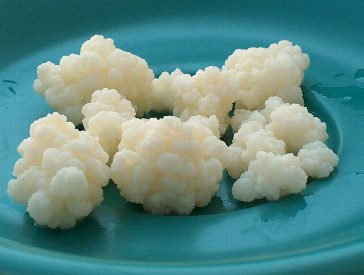In short, kefir is best compared to a "drinkable" plain yogurt in texture and taste. It's made by letting milk (cow, goat, sheep, soy, coconut, etc.) mixed with kefir starter or kefir grains sit out at room temperature for a time (about 24 hours). This lets the milk ferment and what you end up can range anywhere from a thick milk all the way to a cottage cheese texture. Sounds gross, right? And yet that's the same basic process for making yogurt and buttermilk.
{kefir grains}
Well, for one, it's cheap. A kefir grain is a living, growing bacteria/yeast. My dear friend gave me some kefir grains to try out because the ones she purchased grew over time and she was able to split them and thankfully they cost me nothing. (They can be purchased inexpensively to get your started.) Once you have them, if you keep them in ideal conditions, they will continue to grow and you'll never have to buy them again.
One of my favorite reasons is that the process of making kefir is ridiculously easy. It takes a glass jar with a lid, a stainless steel siv, a container to keep your finished kefir in, and three minutes a day.
To start, I place my grains in a mason jar and add about a cup of milk. {The amount of milk added depends on the amount of grains you have and how long you want to leave it to culture.}
Then I place the lid on the jar and leave it on the counter for 24 hours. Once you get a feel for what texture and level of tang you like, it's easier to judge how long to leave the kefir grains in. The tangier, the longer, and the greater the health benefits. 24 hours works for us in the spring and summer but we leave it for about 48 hours in the fall and winter.
Once I have the kefir the way I like it, I sift it through a stainless siv into a glass jar I got from Target and put it in the fridge for when I need it.
That's it!
So now that we've established that I'm cheap and lazy I guess I should share with you a few other reasons we use kefir in our home...
Kefir is good for you. Not just yogurt good.... try 6 times as good. I've heard that whereas yogurt has 5 different beneficial probiotics, kefir has at least 30. It's great for your immune system as as most fermented foods. It's easily digestible. (I've read in several places that it helps break down stuff in milk that makes it hard for lactose-intolerant people to digest.) It's anti fungal and antibiotic. It's full of vitamins and minerals and supports overall digestive health.
There are those who claim that since kefir is such a whole food that it cures EVERYTHING. I cannot speak for many of the claims out there but I found this guy who sure loves it! Anyway..
In our house, we use kefir most often as a substitute for buttermilk, sour cream, milk, or yogurt when baking. However, our absolute favorite way to enjoy it is in smoothies. More specifically, a mix of orange juice, maple syrup and vanilla extract. SO GOOD!
So now that I've filled you in on what kefir is, I'll probably share some recipes with you... but don't worry... if you're thinking kefir's not for you, you can always use yogurt in it's place.






No comments:
Post a Comment
I always love a good comment.